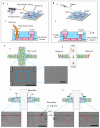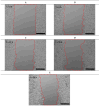Microfluidic Wound-Healing Assay for Comparative Study on Fluid Dynamic, Chemical and Mechanical Wounding on Microglia BV2 Migration
- PMID: 39203655
- PMCID: PMC11356282
- DOI: 10.3390/mi15081004
Microfluidic Wound-Healing Assay for Comparative Study on Fluid Dynamic, Chemical and Mechanical Wounding on Microglia BV2 Migration
Abstract
Microglial cells, or brain immune cells, are highly dynamic and continuously migrate in pathophysiological conditions. Their adhesion, as a physical characteristic, plays a key role in migration. In this study, we presented a microfluidic chip combination of two assays: a microglial BV2 adhesion assay and a wound-healing migration assay. The chip could create the cell-free area (wound) under chemical stimuli with trypsin (chemical assay) and also mechanical stimuli with the PBS flow (mechanical assay). The microfluidic chip functioned as the cell adhesion assay during wounding, when the cell adhesion of microglia BV2 cells was characterized by the cell removal time under various shear stress ranges. The cell detachment pattern on the glass substrate was found under physiological conditions. After wounding, the chip operated as a migration assay; it was shown that cell migration in the cell-free area generated chemically with trypsin was highly improved compared to mechanical cell-free area creations with PBS flow and the scratch assay. Our findings indicated that the increase in inlet flow rate in the mechanical assay led to a reduced experiment time and mechanical force on the cells, which could improve cell migration. Furthermore, the study on the effect of the device geometry showed that the increased channel width had an inhibitory effect on cell migration. The bi-functional chip offers an opportunity for the development of new models for a better understanding of cellular adhesion and migration in in vitro microenvironments.
Keywords: chemical and mechanical wound-healing assays; fluid loading; microfluidic cell adhesion assay; microfluidic migration assay; microglia BV2 cells.
Conflict of interest statement
The authors declare that they have no conflict of interest.
Figures

















References
LinkOut - more resources
Full Text Sources

